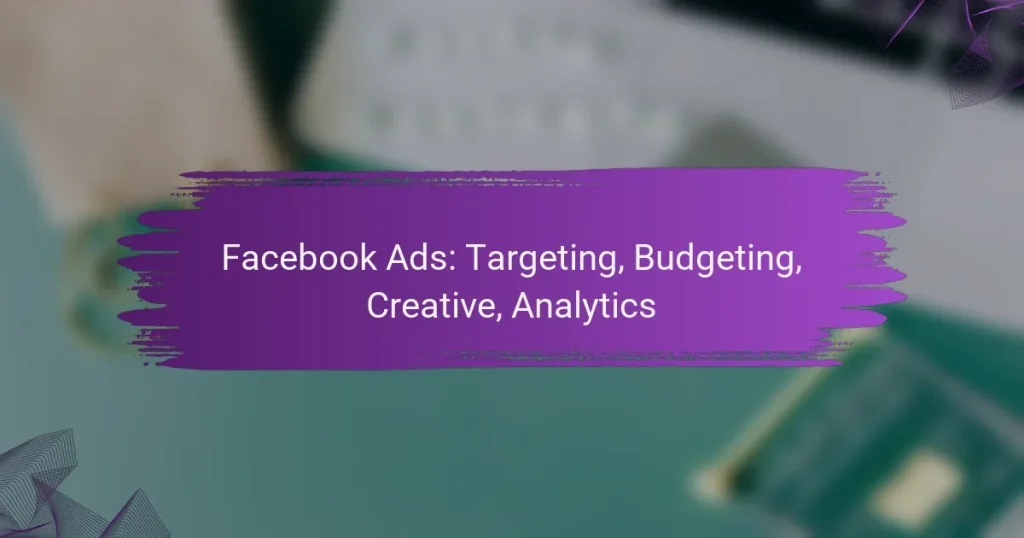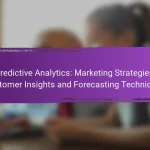Facebook Ads offer powerful tools for targeting, budgeting, and creative engagement, making them essential for successful digital marketing. By carefully selecting your audience and optimizing your budget, you can enhance your ad performance and achieve better returns. Additionally, utilizing diverse creative formats allows you to effectively communicate your message and drive conversions.

How to target the right audience with Facebook Ads?
Targeting the right audience with Facebook Ads is essential for maximizing ad effectiveness and return on investment. By leveraging various targeting options, advertisers can reach users who are more likely to engage with their content and convert into customers.
Custom Audiences
Custom Audiences allow advertisers to reach existing customers or leads by uploading their contact lists to Facebook. This feature is particularly useful for retargeting campaigns, as it enables businesses to reconnect with users who have already shown interest in their products or services.
To create a Custom Audience, navigate to the Audiences section in Facebook Ads Manager, select “Create Audience,” and choose “Custom Audience.” You can upload a CSV file containing email addresses, phone numbers, or user IDs. Ensure that your data complies with privacy regulations.
Lookalike Audiences
Lookalike Audiences help advertisers find new potential customers who share similar characteristics with their existing audience. This targeting method is effective for expanding reach while maintaining relevance.
To create a Lookalike Audience, start with a Custom Audience as your source. Facebook will analyze the traits of this audience and identify new users who resemble them. It’s advisable to choose a Lookalike Audience size between 1% and 10% of the target country’s population for optimal results.
Demographic Targeting
Demographic Targeting allows advertisers to specify audience characteristics such as age, gender, education level, and relationship status. This targeting is crucial for ensuring that your ads reach the most relevant users.
When setting up your campaign, use the “Detailed Targeting” section to refine your audience based on demographics. For example, if you are promoting a product for young adults, you might target users aged 18-24. Be mindful of balancing specificity with audience size to avoid overly narrowing your reach.
Interest Targeting
Interest Targeting enables advertisers to reach users based on their interests, hobbies, and activities. This method is effective for connecting with audiences who are likely to engage with specific content or products.
In the Ads Manager, you can select interests related to your business, such as “fitness,” “technology,” or “travel.” Combining interest targeting with demographic filters can enhance the precision of your audience. However, avoid overly broad interests to maintain relevance.
Behavioral Targeting
Behavioral Targeting focuses on users’ online behaviors, such as purchase history, device usage, and travel patterns. This targeting method allows advertisers to reach users based on their actions rather than just their demographics or interests.
Facebook provides various behavioral categories, including “Frequent Travelers” or “Engaged Shoppers.” By selecting relevant behaviors, you can tailor your ads to users who are more likely to convert. Keep in mind that behavioral data is based on user activity, so it may vary over time.

What budgeting strategies work best for Facebook Ads?
Effective budgeting strategies for Facebook Ads include setting clear objectives, choosing between daily and lifetime budgets, and selecting appropriate bid strategies. Understanding how these elements interact can help optimize ad spend and improve campaign performance.
Daily Budget vs. Lifetime Budget
A daily budget allows you to set a maximum amount to spend each day, providing more control over daily expenditures. This is ideal for campaigns requiring consistent visibility without overspending in a short period.
In contrast, a lifetime budget lets you allocate a total amount for the entire campaign duration, allowing Facebook to optimize spending based on performance. This can be beneficial for campaigns with fluctuating demand or specific time-sensitive goals.
Bid Strategies
Bid strategies determine how much you are willing to pay for ad placements. Common options include automatic bidding, where Facebook optimizes bids to achieve your goals, and manual bidding, which gives you control over the maximum bid amount.
Choosing the right bid strategy depends on your campaign objectives. For instance, if your goal is to maximize reach, automatic bidding may be more effective, while manual bidding can be advantageous for precise cost control.
Cost-per-Click (CPC) Management
Cost-per-click (CPC) management involves setting a maximum amount you are willing to pay for each click on your ad. This strategy is useful for driving traffic to your website or landing page.
To manage CPC effectively, monitor your ad performance regularly and adjust your bids based on the return on investment (ROI). A common approach is to start with a competitive bid and refine it based on the cost-effectiveness of your ads.
Cost-per-Thousand Impressions (CPM) Insights
Cost-per-thousand impressions (CPM) measures the cost of getting your ad seen by a thousand users. This metric is crucial for campaigns focused on brand awareness rather than direct clicks.
When using CPM, consider your target audience and the overall reach you want to achieve. Regularly analyze your CPM rates to ensure they align with your campaign goals and adjust your budget accordingly to maximize visibility without overspending.

What creative formats are effective for Facebook Ads?
Effective Facebook Ads utilize various creative formats to engage users and drive conversions. Choosing the right format depends on your campaign goals, target audience, and the message you want to convey.
Image Ads
Image ads are straightforward and visually appealing, making them a popular choice for brands. A single, high-quality image can capture attention quickly and convey your message effectively.
When creating image ads, consider using bold colors and clear text overlays to enhance visibility. Aim for a resolution of at least 1080 x 1080 pixels to ensure clarity across devices.
Video Ads
Video ads are dynamic and can convey more information than static images. They are effective for storytelling and can showcase products in action, making them engaging for viewers.
Keep videos short, ideally between 15 to 30 seconds, to maintain viewer interest. Use captions since many users watch videos without sound, and ensure the first few seconds grab attention.
Carousel Ads
Carousel ads allow you to showcase multiple images or videos in a single ad, enabling users to swipe through different options. This format is great for highlighting various products or features.
Each card can link to a different landing page, enhancing user engagement. Aim for 3 to 5 cards to keep the experience streamlined and avoid overwhelming viewers.
Collection Ads
Collection ads combine a cover image or video with a series of product images, allowing users to browse and purchase directly from the ad. This format is particularly effective for e-commerce brands.
Utilize high-quality visuals and ensure your products are well-represented. This format can lead to higher conversion rates, especially when paired with a compelling offer or promotion.

How to analyze Facebook Ads performance?
To analyze Facebook Ads performance, focus on key metrics that indicate how well your ads are achieving their objectives. Regularly reviewing these metrics helps optimize campaigns for better results and return on investment.
Key Performance Indicators (KPIs)
Key Performance Indicators (KPIs) are essential metrics that gauge the effectiveness of your Facebook Ads. Common KPIs include Click-Through Rate (CTR), Cost Per Click (CPC), and Return on Ad Spend (ROAS). Tracking these indicators allows you to assess which ads are performing well and which need adjustments.
Consider setting benchmarks for these KPIs based on industry standards. For instance, a CTR of around 1-2% is often seen as average, while a ROAS of 4:1 is typically considered a good return. Adjust your campaigns based on these insights to improve overall performance.
Facebook Ads Manager Tools
Facebook Ads Manager provides a suite of tools to help analyze ad performance effectively. You can view detailed reports on your campaigns, ad sets, and individual ads, allowing for granular analysis. Use the breakdown feature to see performance by demographics, placements, and time.
Utilize the A/B testing feature to compare different ad variations. This can help you identify which creative elements resonate best with your audience. Regularly check the Ads Manager dashboard to stay informed about your campaign’s performance and make data-driven decisions.
Conversion Tracking
Conversion tracking is crucial for understanding how well your Facebook Ads lead to desired actions, such as purchases or sign-ups. Implement the Facebook Pixel on your website to track user interactions and conversions effectively. This tool collects data that helps you measure the effectiveness of your ads.
Set up custom conversions to track specific actions that matter to your business. For example, if you want to measure newsletter sign-ups, create a conversion event for that action. Regularly review this data to optimize your ads and improve your conversion rates, aiming for a conversion rate of around 2-5% for e-commerce campaigns.

What are the prerequisites for successful Facebook Ads campaigns?
Successful Facebook Ads campaigns require clear objectives, thorough audience research, a well-planned budget, compelling creative content, and effective analytics. These elements work together to ensure that your ads reach the right people and achieve your marketing goals.
Clear Campaign Objectives
Establishing clear campaign objectives is essential for guiding your Facebook Ads strategy. Objectives can range from increasing brand awareness to driving sales or generating leads. Defining these goals helps in measuring success and optimizing future campaigns.
Consider using the SMART criteria—Specific, Measurable, Achievable, Relevant, and Time-bound—to formulate your objectives. For example, instead of aiming to “increase sales,” set a goal to “boost online sales by 20% within three months.” This clarity will inform your targeting and creative decisions.
Target Audience Research
Understanding your target audience is crucial for effective Facebook Ads. Conducting thorough audience research allows you to identify demographics, interests, and behaviors that align with your product or service. Utilize Facebook’s Audience Insights tool to gather data about potential customers.
Segment your audience based on factors such as age, location, and purchasing behavior. For instance, if you are selling fitness products, target individuals aged 18-35 who have shown interest in health and wellness. This targeted approach increases the likelihood of engagement and conversion.


